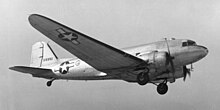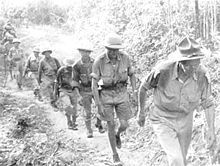Caleb V. Haynes
[1] In the 1930s, Haynes, a rated command pilot, led experimental long-range over-water interception flights that were key to the development of U.S. air defense doctrine.Haynes demonstrated by piloting one of the bombers that intercepted the Italian liner SS Rex that enemy ships could be located and sunk by American aircraft.[1] Haynes was ordered to Crissy Field in San Francisco in August 1924, and transferred to Camp Lewis, Washington, the following June where he served three months as commanding officer of the Air Corps detachment.Under Major John T. "Jack" Fancher in March 1927, Haynes became an instructor of the 116th Observation Squadron, the aerial component of the 41st Division of the Washington National Guard, stationed at Felts Field.[1][2] Following graduation from the school in June 1932, he went to Langley Field, Virginia, for duty as engineering officer of the Eighth Pursuit Group, a unit of fighter aircraft at which he attained the rank of captain.[9] Haynes urgently requested air temperature thermometers to be supplied to all mail planes so that pilots could be warned of possible atmospheric icing conditions, but was forced to operate without them as procurement was to take two months.On August 12–13, 1937, Haynes took part in a joint Army-Navy exercise in which the battleship USS Utah was to be searched for off the coast of San Francisco, and hit with 50-pound (23 kg) water bombs if found.The timing and location had been selected by Admiral William D. Leahy to provide the Utah with the greatest likelihood of fog and cloud cover in which to hide from air observation.Delos Carleton Emmons commanded the Air Corps units from his headquarters at Hamilton Field, and Curtis LeMay served as the main navigator for the bomber group, composed of thirty twin-engine Martin B-10s, seven of the new YB-17s, four B-18 Bolos, and three amphibious aircraft.[9] On the afternoon of August 12, the Navy sent to the airmen directions which were off by one degree of latitude, about 50 miles (80 km) to the east of the ship's actual position, and the bombers did not find the battleship.[10][11] NBC began broadcasting to the U.S. on the main transmitter, while Meloy spoke over the other radio with Captain Cavellini of the Rex, who jokingly invited all of the airmen down for lunch at his table.Aboard another B-17, USAAC's top photographer, Major George W. Goddard, snapped a shot of Haynes and fellow pilot Archibald Y. Smith flying their two B-17s over the Rex "at smokestack level"—Goddard later enthused that the photo "made the front page of every newspaper around the world".After flying back from Mexico City, Haynes and his copilot William D. Old undertook flight tests at Fairfield, Ohio, lifting very heavy loads.A total of 22 round trip flights were made by others in the next three-and-a-half months,[15] however, Haynes was directed to scout another air route across the southern Atlantic from the U.S. to Brazil to Africa, with the terminus in Cairo, Egypt.With the southern route thus proved satisfactory, the UK agreed to purchase 16 B-24s to be delivered by this method to Cairo—one quarter of that number made the trip before the remainder were redirected into American service.[16] In December 1941 at the start of direct involvement of the U.S. in World War II, Haynes was made base commander of Borinquen Field, an important defensive stronghold in the Caribbean and the first refueling stop after Florida in the southern route to Cairo.[4] When Burma appeared to be falling to the Japanese, Haynes and a handful of other airmen of the Chinese National Aviation Corporation and the Royal Air Force flew hundreds of evacuation missions from April to mid-June, bringing some 4,500 passengers westward to safety in India.[19] On May 4, 1942, Haynes flew to rescue 30 members of General Joseph Stilwell's mission when they got cut off in Northern Burma, though "Vinegar Joe" himself refused the lift, preferring to walk out with the remainder of his force.On one such mission, a Japanese fighter attacking his C-47 was discouraged into retreat when the crewmen of the supposedly unarmed transport opened up on it with fire from Thompson submachine guns and 45-caliber M1911 pistols.[5][19] Around this time Tokyo Rose announced on the radio about Haynes that the Japanese would no longer have anything to worry about because the Americans "made that old broken-down transport pilot commander-in-chief".His fighter group counterpart was Scott—the three air leaders were the subject of a Life magazine article in August which described them as like-minded Southerners who "are quietly tough, despise the word can't, eliminate all red tape and allow subordinates full range for individual initiative"."[4] Rarely able to send out more than four or five B-25 Mitchell twin-engine bombers at a time, supported by P-40s each carrying another bomb, Haynes constantly shifted his targets and kept the enemy guessing."[5] One of the earliest offensive efforts made by the new task force was a multi-stage 5,500-mile (8,900 km) voyage from the main base at Karachi, through various Chinese airfields with the ultimate goal of attacking the docks of Hong Kong and returning.The small force destroyed a transport ship, bombed Hong Kong's vital Kowloon Harbor and claimed 27 enemy aircraft for the loss of one bomber and one fighter.After his upcoming air crossing of the Atlantic, his eighth such, Haynes said that the first thing he intended to do was look up his 14-year-old son in high school and his wife who was working in the drafting department at Sperry in Garden City, New York.He became a professor of archaeology at universities in Texas and Arizona, and through his excavation work at Sandia Cave, helped establish the timeline of human migration through North America.Some of the general's friends suggested Wichita Falls, the city of his last military post, but he left to assess the possibility of living in Taos, New Mexico, where he and his airman son hiked and explored ancient human settlements.







Vance HaynesDobson, North CarolinaCarmel, CaliforniaArlington National CemeteryUnited StatesUnited States Army Air ServiceUnited States Army Air CorpsUnited States Army Air ForcesUnited States Air ForceMajor General116th Observation Squadron, 41st Division Aviation37th Pursuit Squadron37th Attack Squadron49th Bombardment Squadron41st Reconnaissance Squadron (Long Range)25th Bombardment GroupBorinquen FieldAssam-Burma-China Ferry CommandChina Air Task ForceTenth Air ForceFirst Air ForceIII Bomber CommandNewfoundland BaseAir Transport CommandSheppard Air Force BaseWorld War IWorld War IIDistinguished Flying CrossMackay TrophyOrder of the Merit of ChileDistinguished Service MedalAir MedalCommendation MedalSilver StarChang BunkerSiamese Twinbombersintercepted the Italian liner SS RexSouth AmericaClaire ChennaultDobsonSurry County, North CarolinaDemocratic PartyDemocratic National ConventionNorth Carolina General AssemblyChineseconjoined twinsMount Airy, North CarolinaWake Forest CollegeBachelor of LawsUnited States ArmyGeorgia Polytechnic InstituteSaint-Maixent-l'ÉcoleGondrecourt-le-ChâteauAir Servicetest pilotIssoudunWoodrow WilsonParis Peace ConferenceMitchel FieldLong IslandSpeedway, IndianaFairfield, OhioWashington, D.C.San Juan, Puerto RicoCrissy FieldSan FranciscoCamp Lewis116th Observation SquadronWashington National GuardFelts FieldSpokaneAir Corps Tactical SchoolMaxwell FieldLangley FieldEighth Pursuit Groupfighter aircraftArmy Air Corps Mail OperationBolling FieldRichmond, Virginiaatmospheric icingRockwell FieldCommand and General Staff SchoolFort Leavenworth, Kansas2nd Bombardment GroupYB-17 Flying FortressRobert OldsBarney M. GilesUSS UtahWilliam D. LeahyDelos Carleton EmmonsHamilton FieldCurtis LeMayMartin B-10sB-18 BolosFrank M. AndrewsHarold L. GeorgeBogotáBuenos AiresInterception of the RexHarris HullWar DepartmentSS RexIra C. EakerSandy HookGeorge W. GoddardPlum Tree IslandChesapeake BayBoeing XB-15American Red CrossSantiago1939 Chillán earthquakePotomac RiverMexico CityNational Aeronautics Association13th Composite WingVI Bomber CommandB-24 LiberatorMontrealGander LakeGeorge H. BrettZhejiangC-47 SkytrainsKarachiRobert Lee Scott, Jr.aviation fuel